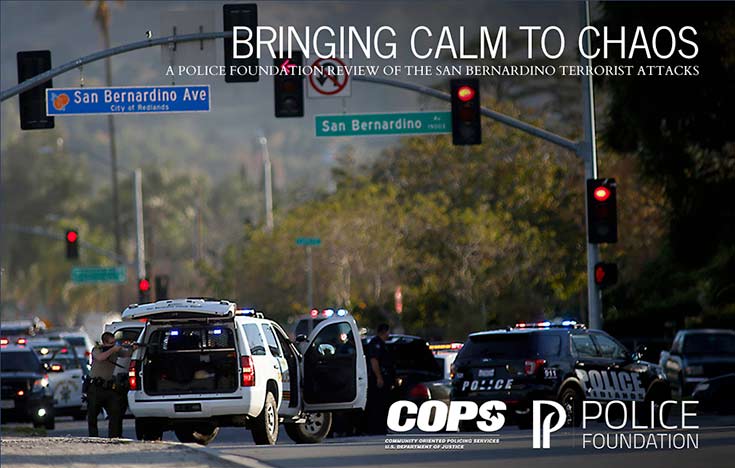A review of the San Bernadino public safety response to 2015 terrorist shooting incident
A critical incident review titled Bringing calm to chaos, looks at the San Bernardino public safety response to the 2015 terrorist shooting incident at the Inland Regional Centre, reports Roger Gomm for CRJ.

The full report can be read online at the Police Foundation's website - click here. Alternatively, it can be downloaded in the link given at the end of this blog
On December 2, 2015, at 10:59hrs, the Inland Regional Centre (IRC) in San Bernardino, California, came under attack. The incident began as what is now known to be two shooters, dressed in all black, entered the IRC, a building in which San Bernardino County Environmental Health Department employees were meeting, and began shooting.
In a matter of minutes, the couple fired more than 100 .223 rounds, before they fled in a rented SUV. The attack led to a midday shootout between the police and Rizwan (male criminal) and his wife Tashfeen Malik (female criminal), as well as a search for a third subject some officers believed had fled the suspects’ vehicle (it was later determined that there was not a third suspect). Law enforcement officers killed both assailants on a normally peaceful residential street.
The incident left 22 civilians wounded, 14 civilians dead, and two officers injured. Two days later, after an investigation into the assailants’ background and motivation, it was realised that this was a premeditated act of terrorism.
This incident was a fast moving and challenging incident for responding agencies operating in the full glare of the media. The purpose of this Office of Community Oriented Policing Services (COPS Office) Critical Incident Review was to: “Critically, objectively, and thoroughly examine the public safety response – including preparation and aftermath – to the December 2, 2015, terrorist shooting in San Bernardino.”
This review provides a detailed overview of the incident response; lessons learnt to improve responding agencies' policies, procedures, tactics, systems, culture, and relationships; and guidance to other agencies and first responders as they prepare for responses to terrorist, active shooter or other hostile events, or mass casualty incidents.
Some of the key themes include the following:
-
Build relationships: leader-to-leader, organisation-to-organisation and police-to-community prior to a critical incident: At both the operational and strategic levels, the responders who were interviewed attributed much of the success of the response to these attacks to the relationships they had built regionally through training and working with others.
-
Review, study, and apply lessons learnt from critical incident reviews: Lessons learnt from the Police Foundation review of the Christopher Dorner incident in 2013 contributed to the response to the December terrorist shooting at the IRC.
-
Regional public safety partners should plan and exercise unified command for complex incidents on a regular basis. The need for an ‘understood’ multi-agency incident command structure to manage a marauding terrorist attack or other hostile events would seem obvious but, in reality, the key is regular joint training and implementation during routine events and emergencies.
-
Conducting regional multi-agency training improves response: The report highlights the need to ensure that training is inclusive, involving public safety agencies, medical community, legislators, other governmental organisations, faith leaders, mental health providers and others. Training should extend past the initial response into transition to victim extraction and all the way through family notifications.
-
Prepare and use equipment and technology to keep officers and community members safe and informed.
-
Attend to community, victim, and officer wellness: Active shooter or other hostile events are devastating to a community, to the victims and to the public safety personnel responding to them. It is critical that departments plan and work with mental health, faith, and other partners to accommodate victims and witnesses and provide the necessary welfare resources.
It is worth reflecting on the US State and local law enforcement organisations’ structure as there are many, different in size and capability, which emphasises the need for co-operation highlighted above. In 2015/16, San Bernardino Police Department had 248 officers and 173 civilian staff. The terrorist shooting at the IRC and the final shootout between the terrorists and law enforcement occurred within their jurisdiction. Their officers were first on scene and the department, in conjunction with the San Bernardino County Sheriff’s Department (which serves 14 of the county’s 24 cities and has 3,571 employees) and the Federal Bureau of Investigation (FBI), maintained primary incident command. Such operational understanding does not happen by chance and they should be congratulated.
I would recommend the report to all agencies developing plans for the response to and recover from a marauding terrorist attack or similar incident.
The full report is available in PDF format here
Roger Gomm QPM, is Advisor, Trainer, Consultant, Associate Lecturer, Cabinet Office Emergency Planning College, UK and a Member of CRJ's Editorial Advisory Panel
Roger Gomm, 23/09/2016